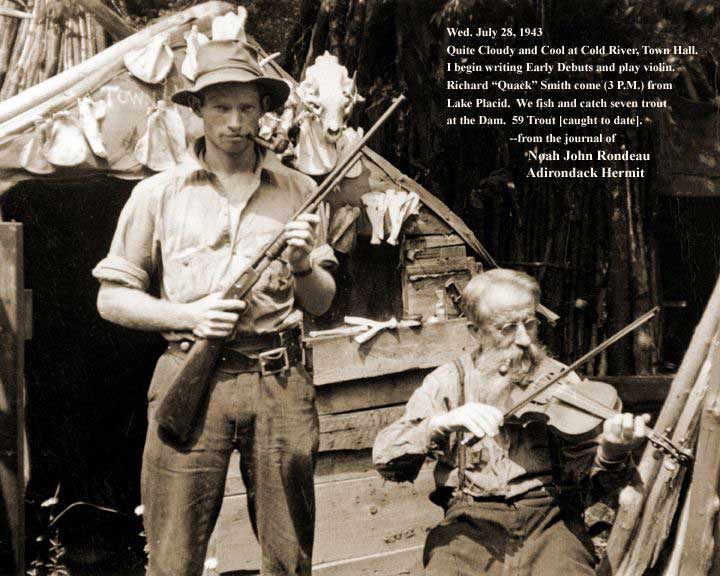

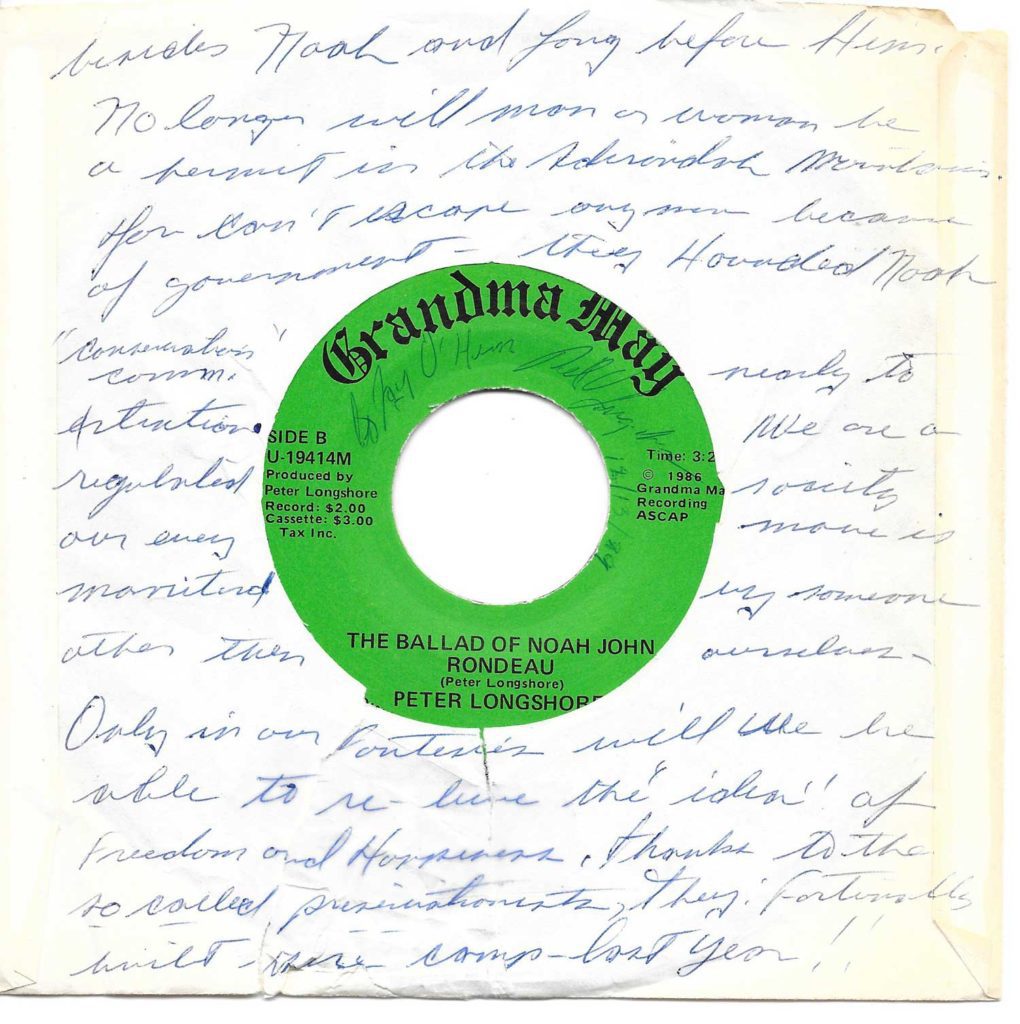



Harvey Carr took on the arduous job of moving the [hermit’s] cabin to the [Adirondack] museum. He painstakingly numbered each log, each board, and each item, carefully dismantled it all …
The Hermit and Us – Our Adirondack Adventures with Noah John Rondeau
An excerpt from “The Hermit and Us”, Starting on page 220
“Harvey Carr was another Blue Mountain Laker. He worked as a logger for a spool company. His company had either bought land in the Cold River country or the timber rights, I don’t remember. I don’t think Harvey knew anything about us knowing Noah John until he approached Monty and me saying it was ‘a shame’ Rondeau’s cabin was about to be bulldozed. Harvey had been living back there, staying in an established lumber camp. He hoped that we could help him to rescue one of the cabins. Although we really had no idea on how to go about it, we agreed to at least try. One day shortly after we agreed to help, Harvey took his wife, Mary, and us into Rondeau’s old camp site on top of Cold River Hill.
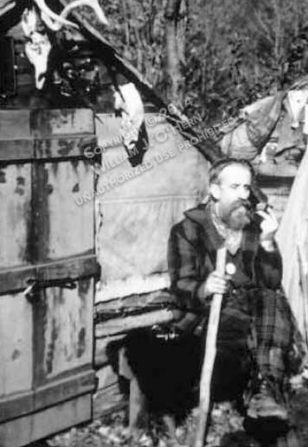
Courtesy of Ruth King
Noah was pleased to know his past way of life would be preserved in the Adirondack Museum’s display of his hermitage.
After seeing the little dwellings and having talked at length with the grand gentleman Noah John was, we felt that the Adirondack Museum should indeed find it an interesting exhibit. By the way, thinking at the time the cabins would almost certainly be bulldozed, I took Noah John’s big white coffee cup as a reminder. It is now on the table in the cabin at the museum. “As I said before, Monty talked to Mr. Bruce Inverarity. He was the first director of the new museum. Inverarity had heard of Rondeau. He felt that the Adirondack hermit, because of Rondeau’s appearances at the Sportsmen’s Shows, was commercial and a fake. He also assumed that Rondeau had made a small fortune out of that. Quite the contrary was true. Actually Noah John had been taken advantage of. The sporting goods manufacturers only paid for his expenses and one hundred dollars
for each show appearance …
If I remember correctly, it was not until after the success of the Enoch Squires story that Mr. Inverarity rather grudgingly consented to accept the cabin into the museum grounds where it became, if not the museum’s most popular all-time exhibit, certainly the most popular at that time.
“As soon as that permission was granted, Harvey Carr took on the arduous job of moving the cabin to the museum. He painstakingly numbered each log, each board, and each item, carefully dismantled it all, prepared it for travel the long way out over the rough logging road and then was almost defeated trying to get some help and some way of transportation out [to the museum]. I think one man [Paul Crofut] helped him after he had gotten the consent of the museum to send a truck. Then Harvey put it all carefully together again on the farthest-out perimeter of the grounds.” Eleanor ended her last letter by bringing the cabin placement up to date. “Unfortunately, exposed log cabins do not last too long. Therefore, several years ago, under a new director, the exhibit was moved indoors.” Richard Smith would probably have been right had I placed a bet with him. A hermit in the 1940s and ’50s would have been more popular than he ever would be in the 21st century. But, as late as the 1980s and ’90s, when I was presenting historical slide programs for Adirondack Discovery throughout the Adirondack Park and for the elderhostel program at Sag- amore Institute at Raquette Lake, I realized that the majority of people in attendance still wanted to learn more about the Adirondack hermit.
“Now it was my turn to inquire about Rondeau’s writings. He certainly had ample enough opportunity to give Thoreau some stiff competition in the literary-hermit field
The Hermit and Us – Our Adirondack Adventures with Noah John Rondeau
An excerpt from “The Hermit and Us”, Starting on page 212
Seated in the small, snug cabin made partly of logs, partly of rough sawn boards Noah salvaged from a deserted lumber shanty, Ed thought of his buddy waiting in an adjacent wigwam that provided a camping place for hikers, fishermen, and hunters who came this way and wanted to bed down on the bluff above Cold River. Jack was no doubt studying the pole structures and had discovered they served as Rondeau’s woodpiles, as Ed was gearing up to learn a few things that were still on his mind.
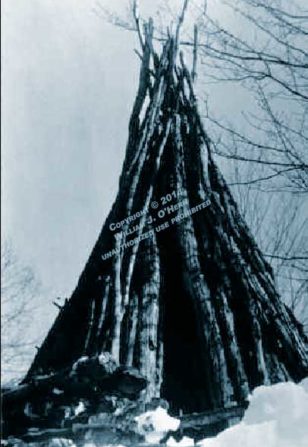
Courtesy of Peggy and Wayne Byrne
Noah’s method of drying firewood stacked into wigwams added to Cold River Hill’s mystique. Each mass had a name: Beauty Parlor, Mrs. Rondeau’s Kitchenette, Meat Wigwam, Pyramid of Giza, Summer Wigwam.
“Now it was my turn to inquire about Rondeau’s writings. He certainly had ample enough opportunity to give Thoreau some stiff competition in the literary-hermit field—if he wanted to work at it. Rondeau claimed he made almost daily entries in his diary. I was dismayed when he told me that much of his writings were in coded hieroglyphics.
“Next, Rondeau brought out one of his coded books. I looked at it and wondered why anyone would spend so much time writing something no one else could decipher unless it was to describe the location of a hidden treasure. So I asked what the purpose of writing in code was if its value dies with its creator. ‘It’s so no one else can read it,’ was Rondeau’s curt reply. Evidently he did not think it an onerous and senseless way of keeping things to himself. Maybe they were not worth reading. On the other hand, maybe they were directions to cached traps and overnight camps, great fishing holes, set locations for taking fur bearers or special deer hunting watches. Maybe, it was just a game he was playing with people so they could always have something to talk about. He also mentioned that he was working on his autobiography. Of course, he would want others to read his autobiography, so it would not be coded. That he would produce a finished literary work of any kind in this primitive environment would be highly commendable, I thought.
“Twenty years after my visit, part of Rondeau’s literary legacy became known to the world when Maitland De Sormo of Saranac Lake published the book Noah John Rondeau, Adirondack Hermit. The book contains Rondeau’s “Recollections of Sixty Years,” excerpts from his journals, and some of his colorful poems, all more or less untouched to preserve the rustic flavor of the self-educated man. I promptly bought one. It is still one of the best-selling Adirondack books about a genuine lover of the wilderness.
Before leaving the hermitage, Rondeau gave us a final tour of his tiny municipality in the wilderness. The many bones and skulls hanging from buildings or laying on the ground he identified as those of deer and bear and various fur bearers. Unlike Thoreau, this hermit was a hunter and trapper, a good rifle shot and something of a bowman who crafted his own bow and arrows. Thoreau, however, had a good eye for finding ancient arrowheads on his many walks.”
Talking about Thoreau with a real, live hermit deep in the Adirondack wilderness was a great experience. There could not have been a better classroom for such a discussion.
The Hermit and Us – Our Adirondack Adventures with Noah John Rondeau
An excerpt from “The Hermit and Us”, Starting on page 209
He also valued the philosophy of Henry David Thoreau. “From my middle teenage years, I had self-Thoreauized myself — so now I needed a little real-life Rondeauizing to give balance to the bookish ideas as to what a hermit is really like in the wilds. Rondeau was a primitive Thoreau, a Thoreau gone to the wilderness instead of Walden Pond.”
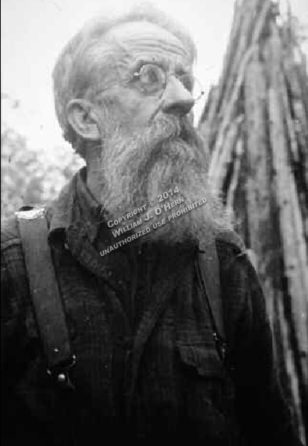
“With this in mind, I could not help but bring up the subject of Walden and its author, Henry David Thoreau. Rondeau said he had read Thoreau but did not think much of him as a hermit. Then, in a short diatribe, he blasted the sage of Walden Pond. To a young disciple of Thoreau, this was embarrassing and unnerving. Though his acid criticisms seemed unjust, I listened. ‘You call Thoreau a hermit,’ barked Noah, ‘when he spent less than two years at Walden Pond and walked into town almost every day to see his folks. He may be the most talked-about hermit, but to me he was a phony.’”
Noah admitted to reading quite a bit. “Back here I would take a kind of course, like something — astronomy, religion, philosophy or something like that just on my own authority. I’d get a few good books and when I’d get through with it, I’d know more than when I started.” …
Ed said, “I considered Noah’s words but did not know if they had anything to do with Thoreau. If people considered him a worthy hermit, that was one thing, but the fact is Walden was a part of Thoreau’s deliberate experiment to put transcendental theories into a life form and he did it. Noah had a firm and narrow concept as to what made a hermit authentic. Evidently, it was not what he [Thoreau] accomplished, but how long he stayed. So, Thoreau was verbally excluded from his fraternity of hermits.
Nor would he give him any credit for sublimating the solitary life. His fiery criticism of the 19th century sage assured me, however, that Noah was probably one of Thoreau’s most unusual and most avid readers …
Edwin’s thoughts swung back to comparing Thoreau and Rondeau. “Both hermits were good with their hands in repairing and building things. This basic skill of self-reliance appears to be one of the prime requirements for a successful hermit.
“As far as formal education went, Rondeau, an elementary school dropout, had very little. On the other hand, Thoreau grew up in an atmosphere of intellectualism, in close contact with such great minds as Ralph Waldo Emerson.
“Talking about Thoreau with a real, live hermit deep in the Adirondack wilderness was a great experience. There could not have been a better classroom for such a discussion. In this environment, however, Thoreau seemed at a terrible disadvantage, not only because he could not represent himself, but because he seemed tame and academic, and not the man of the wilderness often depicted in books by his modern-day admirers, but a man of the gentle, pastoral scene.
Klein’s Memories of Noah: In 1991, Stephen Klein Jr. wrote about his first meeting with the hermit and a gesture of kindness.
The Hermit and Us – Our Adirondack Adventures with Noah John Rondeau
An excerpt from “The Hermit and Us”, Starting on page 194
In 1991, Stephen Klein Jr. wrote about his first meeting with the hermit and a gesture of kindness.
“I’ve admired Noah ever since I shook hands with him in New York City when they had his set-up in the Sports Show in 1947. I was 17 years old then. Me and two of my friends went to the Grand Central Palace. We had to wait in line [to see the hermit]. I…got his autograph on the show program…”
The next summer Klein visited Rondeau at Cold River. Forty-two years later, Klein duplicated that trip twice for the express purpose of commemorating his idol.
“… I hiked back twice that year [to Rondeau’s site] in one day. Each time I took my boat to Plumley’s Landing on Long Lake. From there I hoofed it over the N.P trail. It was eleven miles one way. I hiked 22 miles in 10 hours …

From Noah’s photo album. Courtesy of Richard J. Smith
Young and old alike enjoyed meeting Noah. Stephen Klein Jr. said, “I used to beach my boat at Plumley’s Landing, hike along the N-P Trail to Cold River Hill and return to my boat all in one day — 22 miles in 10 hours.”
There wasn’t much left there from when I first dropped in on the hermit. I saw the sign needed replacing…so I returned with a handmade one with the type engraved into the wood and then filled in with paint…I go to the [Adirondack] museum every year to see Noah’s display …”
Scoutmaster Erwin Miller reflected upon the stir the hermit made when they brought him to a sportsmen’s show at Madison Square Gardens.
The Hermit and Us – Our Adirondack Adventures with Noah John Rondeau
An excerpt from “The Hermit and Us”, Starting on page 191
As our interview drew to a close, Erwin shook his head in wonder, then looked for a moment as if he had another thought. He then shook his head again confidently, and started a last recollection.
“In the late 1940s my Explorer Post was looking at projects, fund raisers, for a log cabin meeting place we planned to build. Some of our committee had visited Noah at Cold River and thought it would be a hoot to see an old friend at New York City’s Madison Square Garden for the February 1947 Sportsmen’s Show.
“We could not help to notice how Noah’s lifestyle and social status had taken a considerable turn because of that show. Newspapers heralded his airlift from his wilderness hermitage by helicopter. Rondeau was set up in a simulated forest environment at the Garden. He turned out to be the show’s main attraction. Although paid a $100 fee for his appearance, the enterprising hermit placed his large pack basket at the edge of the display into which the crowds could contribute coins and bills toward a poor hermit’s well-being. He also sold pictures of himself (for which he paid one-half cent each) for twenty-five cents apiece, fifty cents if autographed. He loved signing his name. We heard his ire, though, when he talked about the light-fingered gentry who occasionally made off with one of his photos at the show.
“It was then we decided that it would be a great experience for our explorers to run such a show in Burnt Hills. We started organizing the show months in advance. We requested the Conservation Department to make Noah available for our local show. They did so and he stayed at my home for two nights.
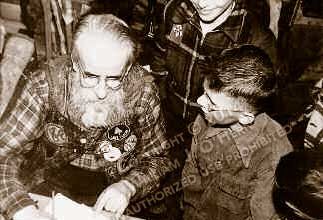
Courtesy of Richard J. Smith
Noah autographing a picture for a wide-eyed youth.
We had a great exhibition with all the attractions expected at an outdoor extravaganza. My daughter was about three years old at the time and she sat on Noah’s lap in a rocking chair. His long beard fascinated her and he seemed to enjoy entertaining her. He was soft-spoken and very clean — not a rough and gruff backwoods creature. His language proved he had some education and enjoyed literature. My wife remembers our daughter believing that he was a Santa Claus. He was a salesman and loved to push his photographs, etc. He enjoyed our conventional breakfast.
The following year, 1948, we learned Noah received five hundred dollars for appearing in Boston’s Sportsmen’s and accordingly jumped his picture rates to fifty cents and a dollar.”
And with that last recollection, Erwin H. Miller, former Scoutmaster and Explorer advisor, found himself heading for Cold River Hill in his mind, listening to the soft rushing waters of Cold River, to the crackle of a camp- fire ringed with delighted scouts, and perhaps to the haunting sound of an old hermit’s fiddle.
Noah lived the skills taught in the scouting “Handbook for Boys” — just as he could have written the Handbook for Hermits.
The Hermit and Us – Our Adirondack Adventures with Noah John Rondeau
An excerpt from “The Hermit and Us”, Starting on page 182
A long-time mountain-dwelling hermit with a long grey beard who stood about five feet two inches and dressed in much-patched clothes and a floppy, green-painted hat is not like any other model a scoutmaster could point his charges to as an example of how to survive. But Noah lived the skills taught in the scouting Handbook for Boys — just as he could have written the Handbook for Hermits.
For the troops of Boy Scouts who took a walk in the woods to reach the hermitage, most found the long day hike a modest distance even with the weight they packed on their backs. Cold River Hill was not a random destination. The Cold River Valley was not the cultivated urbane orb of paved streets, smelly buses, crowded housing developments, school playgrounds, and city parks. On camporee weekends, scouts usually pitched their tents on the outskirts of such cities in former orchards and on pastureland that substituted for the wilds. Meeting a most curious mountain man must have seemed a novel and worthwhile goal.
Long before Noah’s rise to prominence in the media, many scoutmasters from Vermont, Pennsylvania, New York’s Capital District, the Southern Tier, central New York and points beyond had learned of Rondeau’s digs. Cold River City was a first-hand example of a man’s successful attempt to survive in the wilderness.
Scoutmasters might have described a hermit as a person
who is usually anti-social for numerous reasons, and becomes isolated by preference. As they led their young charges toward Cold River, they might have qualified that definition, joking “He might even offer you some of his ‘Eternity Tea’ or ‘Everlasting Stew,’ which if made from a blue-jay, might be heartier by leaving a few of the feathers and what-not intact.”
The former campers and scouts, now elderly, enjoy their easy chairs and memories of their favorite wild places.
Caution tossed aside, youthful visitors found Noah John “warm and friendly,” according to H.P. Donlon’s remembrance, “with merriment that was joyous.” He entertained his scouting visitors with stories and fiddle music, in a fashion they would almost certainly have found unique.
Courtesy of Richard J. Smith
May 1951. Rotary Fair, Malone, N.Y. From Noah’s photo album.
They also heard Noah’s salty commentary about his dislikes and learned about various facets of his life, including his long romance with the Cold River country, starting with his first hunting trip there in 1902. His choice of words was of special interest. Noah was inclined to throw big words into the conversation. Many did nothing for the subject, but considering his lack of formal education, his vocabulary made fascinating listening.
Along with whimsical weather and nature notes and a record of the hermit’s daily “doings,” he managed to work off steam on most of his pet peeves—the game protectors, politicians, “big fool American business,” and officialdom in general. No target was too big, as witnessed by some savagely caustic references to Franklin D. Roosevelt.
The hermit’s journals record the crowding on dusty Deer and Main Street.
August 13, 1941 Wednesday
Cool. Hall of Records. 11 scouts from Vermont
camp came. (Come [and] go.) 400 cents [they paid] for guide. Hail Hitler.
July 21, 1944 Friday
Rain last night. Cloudy and showers today. At Town Hall, Cold River. Six Scouts and a Scout Master from Riverdale called. At dusk- castor- 99 fish.
Trials of Youth: Fred R. Studer was one of the youthful backpackers Noah referenced in his 14 September 1946 entry. “We knew very little about Noah John Rondeau. “
The Hermit and Us – Our Adirondack Adventures with Noah John Rondeau
An excerpt from “The Hermit and Us”, Starting on page 168
Saturday, September 14, 1946
At Beauty Parlor.
A perfect September day. 4 men call
(3 Schenectady and 1 Michigan).
I see Venus 40 times in 3 hours before sundown.
—Noah John Rondeau’s memorandum
Fred R. Studer was one of the youthful backpackers Noah referenced in his 14 September 1946 entry. In Studer’s 1991 interview, he told me an interesting observation he made during his group’s end-to-end Northville- Lake Placid trek. “The natives of the Adirondacks had a different outlook on life than the partners in my group.” For example, “The average native [of the mountains] couldn’t understand why anyone would take their leisure time and climb mountains.”
Studer continued his recollection of September 14, 1946:
We were lacking many of the conveniences available today. Dried potatoes and dried eggs were unavailable … in short, camping took a lot more planning, ingenuity, effort and so forth than it does now. In like manner I feel sure hermiting then was far more of a challenge than it would be now … We knew very little about Noah John Rondeau. As we approached his place we had no idea of what to expect. We did expect him to be sort of a backwoods, native, Adirondacks type.
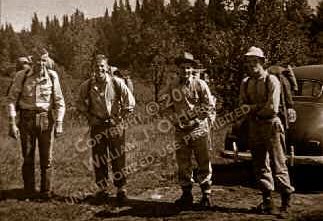
Courtesy of Fred R. Sutor
1946. Bill White, Fred Studer, Bill Barzler and Phil Rumbolt. The backpackers talked about their future the entire camping trip. They had an opportunity to make a living in the civilized world or, kidded Fred, “We could become hermits. We might even make a name for ourselves.”
Earlier visitors described the hermit’s yard as a “pig pen.” It was unjust and false. When Fred Studer and his three college-bound friends approached the entrance to Rondeau’s bailiwick, which had become an almost legendary destination in the Adirondacks down through the years, they first spotted the tall wooden teepees on the horizon, then the tattered banner over the spur trail’s entry that announced Welcome to the City. Iron kettles planted in pansies hung from the center of pole tripods on each side of the proclamation. The man-made beauty on a semi-wooded sand bank aside the edge of a water waste — the flow ground—additionally greeted guests to the municipality. The host extended his typical hospitality. His greeting “had an air of formality.” On first reaching his cabin, the men were asked to “sign my guest register.”
So imagine the excitement of the four backpackers, raised in an urban environment, when they happened upon Noah just prior to his grand media exposure.
December 18, 1943. Wind and snow filled my trails. At Beauty Parlor, Cold River. I move Quack’s Wisdom to Bellyache Swamp. I set 4 traps for Fox, Fisher, Rabbit.
December 18, 1943. Quite Mild, gloomy, very cloudy and snowing a bit.
Sat. December 18, 1943. Quite Mild, gloomy, very cloudy and snowing a bit. Wind and snow filled my trails. At Beauty Parlor, Cold River. It looks very wintery. I move Quack’s Wisdom to Bellyache Swamp. I set 4 traps for Fox, Fisher, Rabbit. I take a random Scoot in the Hills and Swamps. I got a Rabbit and 4 PM I see a Deer at dam.
Whether late fall, early winter, spring or summer, Noah enjoyed taking walks. “Random Scoots” was his term for relaxing and enjoyable walks. He has said of spring rambles as an example of what he found enjoyable: “walks in the open pasture, stopping to look up along the hills where the woods met the pasture. Robins whisper and laugh and song sparrows jingle their small change. All the while watching the weather so it don’t run away. I watched the grass greening and listened to vernal song birds….” On a random scoot a few weeks earlier in November he said, “I looked over my rusty nails and saws and conclude I’m nearly as rich as I was a year ago.”
Noah’s nephew Burton Rondeau remembers his uncle saying about trapping wily foxes: “‛Well, lucky thing you have a hermit here to teach you how to catch a fox,’ he’d tell me with a chuckle.” And, like other storytellers, Noah often had a twist to a telling, as Burton revealed when he attempted to recreate his uncle’s instructions. “You get yourself some boards and nails and a hammer and saw and build a box, a cage you see. Then you attach a door and a trip peg and tie a rope to the door. Lift it into the open position, hold on to the rope and get behind the box. Then you make a noise like a dead hen.”
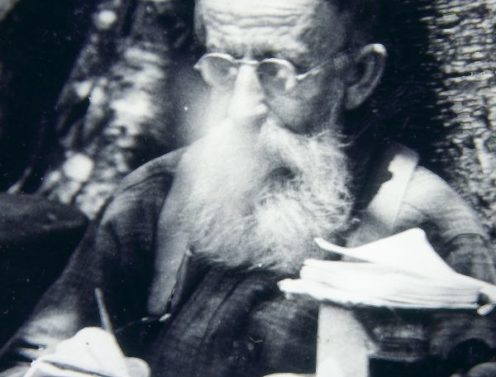
Although Burton has told that remembered story many times, he laughs as much now as he did when Uncle Noah first told it. “That’s the kind of thing that went on. Stories like that. As kids we were always plugging him to tell us stories and he liked that.
“Here’s a snapshot of Noah at our wedding reception,” said Burton as we reached the end of my interview. “It was an all-day event.” He laughed, “I’m sure Noah had a drink or two that day with all the Rondeaus along the road.”
“When it was time for Uncle Noah to return to the river, Dad would drive. I remember his full pack basket and long walking stick and the galvanized pail he would carry. He had to be athletic in order to face both physical and mental hardship. For Uncle Noah to make such a journey in the Adirondack wilds for over thirty years, through mountains and desolate, freezing landscapes, was considered foolhardy by some people, who discussed how he might never return. True, his mission might have seemed to border on suicide, but time after time Noah had proven himself a strong woodsman.”
Steve Rock, who comes from a younger generation on a limb of the Rondeau-Rock family tree, wishes he knew more about his Uncle Noah. He and Jenny are examples of the current generation who treasure the memories of Uncle Noah. Said Steve: “The stories told to me were much the same as in De Sormo’s book [Noah John Rondeau, Adirondack Hermit]. The story of his not worshipping in our churches is true, for he did show up at my Grandfather [Herbert] Rock’s funeral in a bearskin robe but chose to stand outside the church door. As my Grandmother Delia exited the church, she stopped to talk with Noah. He offered his condolences, hugged her, then pressed a wad of bills into her hand. My dad said the roll included a hundred-dollar denomination. There possibly was more, as Dad said everything was rolled. That was a lot of money in 1958!! Quite amazing.
“Off and on throughout the 1950s and early ’60s I recall Uncle Clifton telling me that when Noah did visit Delia in Cadyville he always brought along a deer head. He always assumed it was stashed with something important. Money? He didn’t know. Uncle Clifton was a storyteller who in the telling made the truth, a lot of times, sound better [than it really was].
“Uncle Chester [Rock] might remember more stories [about Noah]. He helped care for my grandparents, being a nurse. He was frequently at their home when Noah visited. Noah stayed in one of the upstairs bedrooms during the later 1950s.”
Chester Rock was only four and a half years old in 1943 when Noah recorded the following entry in his journal.
January 25, 1943: Monday, Cloudy, Thawing! Black Brook and Au Sable Forks. At William Rondeau at Black Brook. Herbert and Delia Rock from Cadyville call to see me. Mrs. Delia Rock is my Sister whom I have not seen in 23 years and 3 days. 3 PM at Au Sable Forks. 5 PM at McCasland.
Chester doesn’t have any memories of Noah on this day that Noah reunited with his baby sister, who was then 46. It’s all conjecture why he had not seen Delia since the last days of 1919. They had grown up during hard times and experienced joyful times as well. They must have had a lot to talk about.
Burton continues: Uncle Noah told the kind of stories that kept you awake long after the rest of the house had fallen asleep. He had a God-given knack for spinning a yarn, and his tales were nothing short of spectacular to me as a young boy. Noah was known for his little gems. At least we [the family] think he had a way with words when expressing common, everyday things. His writing is just one of the things I enjoy looking back on.”
Every time Chester would remember something else, I’d receive another e-mail with the subject line “Memory Crept In,” and would open it eagerly. In one correspondence, Chester thought back to Noah’s Bible. “One day I stopped to see Aunt Delia Rondeau, Uncle Bill’s wife, a few years after Uncle Noah died. She gave me a Bible that Uncle Noah kept. As I thumbed through the pages I noticed Noah had added something to all the pictures. He had covered many of the captions under the pictures by cutting pieces of the glue tab of envelopes and pasting them over the writing. On the tabs he added his own comments. Some were derogatory remarks next to the [original] text. In other cases, he jotted comments. Some of the writing you could make out and in other cases the ink was smeared.”
Chester was referring to the large Bible Rondeau had been given in “about 1925.” Noah marked this on the inside cover:
“This Bible: I got in the twenties; and smoked it in Cold River Town Hall for over 20 years; And brought it to Saranac Lake, Nov. 14, 1948.”
N.J. Rondeau”
Recalling the his uncle’s secret code, said Chester, “All my brothers and sisters were just as curious about Uncle Noah’s secret writing as I was. There wasn’t ever much time to snoop in the journals, as if Mother caught us there would be trouble! I did think, however, that I would like to have been able to take my time thumbing through all the pages.”
December 16, 1943. Calm and Perfect Sun. Handsome View. I shovel trail to Shithouse and I Shit.
December 16, 1943. Calm and Perfect Sun. Handsome View. I shovel trail to Shithouse and I Shit.
December 16, 1943. Calm and Perfect Sun. Handsome View. I shovel trail to Shithouse and I Shit.
Graphic as his diary entry is, I’m sure the hermit did more than just shovel snow. I know it’s a fact that his outhouse was placed so he could look out across Cold River and take in the view of Panther Peak.
Rev. Ben Klauser was a visitor to the hermitage. Noah commented about him on September 4, 1945 when he wrote in code “OLD LADY’S WIGWAM. A PERFECT SUMMER DAY. PRIESTS STAY & CLIMB COUCHSACHRAGA, PANTHER. 1 HOLY FATHER LOST UPRIVER …”
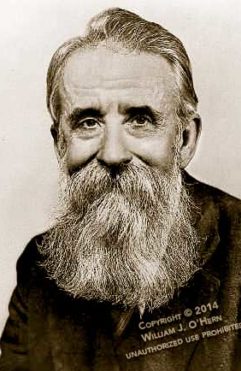
As others have reported following their camping experience on Cold River Hill, the Mayor of the City always left the impression he was scarcely bothered by anything in the world around him. “I’m never bothered with the assessors or the tax collector, anyway,” he’d quip. He was also not lonely.
In the course of many confabs Klauser had with Noah, he had heard all about the isolation — those long years, the rainy days and evenings when he couldn’t venture outside and those winters when snowstorms would pile up deep snow. Noah’s homespun philosophy neatly summed those times up. “I prefer to think of it all as solitude.” And he was right when you think of it. There is a difference between loneliness and solitude. He’d read Thoreau and liked to joke that he distanced himself from the philosopher, because his Town Hall was “farther back from the cookie jar than Walden Pond ever was.

“No, I’m not lonely. Loneliness is only a state of mind. I’ve been more lonesome waitin’ two hours in a railroad station than in a whole cold winter alone in the mountains. Lonesomeness isn’t jest when you’re alone; it’s when you’re destitute and lost. Some people can be lonelier in a crowded railroad station than I can right here in my woods,” was his standard answer when asked if he ever felt lonely.
It might have seemed strange to look about Cold River City and discover the hermit had no pet. Why? “That’s simple,” he’d explain. “I never did like cats and dogs. I could have a pet raccoon or a fawn, but that would be cruel to keep them away from their woods.”
While he didn’t live his life with respect to a reverence for a higher power, Noah did have his own “Higher Authority” ideas. He would say he had no religion, “but it isn’t that I’m against it — I just don’t even think about it.” The statement is contrary to his actions, however. He numbered among his friends two Catholic priests who tarried overnight with him and, according to Noah, “we talked theology by the hour over my campfire.”
The heavens declare the glory of God, And the firmament showeth His handiwork …
— Psalm 19
Rev. Klauser liked this canticle. He found peace among Noah’s mountains. Noah believed “Mountain climbers are good folks, mostly,” and with few exceptions, they were also spiritual folks. It seems as though in the mountains one feels closer to God, or whatever or whoever one thinks of as a higher power.